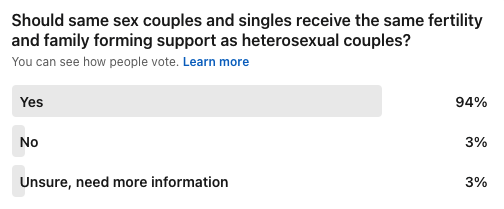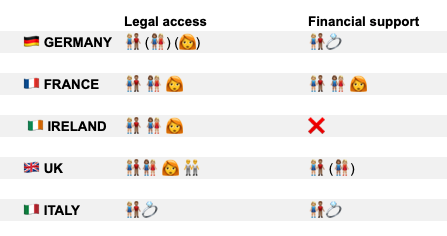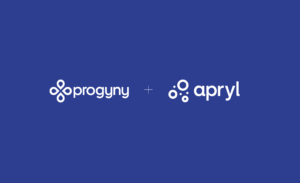To many, the term fertility equality might be new, but the struggles it is trying to tackle have been around for decades.
What is fertility inequality?
Infertility is defined as the inability to conceive after 12 months of intercourse. The problem with this definition is that it excludes the needs of having children for alternative family models such as same-sex couples and single people, consequently prohibiting them from fertility treatment in Europe and resulting in inequality.
Many possibilities, too little access
Thanks to modern medical procedures, female same-sex couples and single women can easily become mothers without a male partner. By the use of insemination or in-vitro fertilisation using donor sperm, pregnancy and motherhood can be achieved without a male partner involved.
Male same-sex couples and single men can become dads with the help of a surrogate mother, meaning that they donate their sperm to fertilise either a donor egg or the surrogate mother’s egg and having the surrogate carry the pregnancy to term.
However, these possibilities prove to be far away for many in reality due to lack of legal access and financial support.

Fertility inequality in Europe:
- Some countries legally deny the LGBTQ+ community and singles access to fertility treatments in general (e.g. Italy)
- Some may allow for treatment but discriminate against same-sex couples and single women when it comes to financial support in comparison with heterosexual couples (e.g. UK)
- Some countries allow treatment access to same-sex couples and single women, but prohibit surrogacy, excluding male same-sex couples completely (e.g. Spain, Sweden)
- Some countries require couples to be married before gaining any financial support (e.g. Germany) and yet others categorically forget about anyone who can’t get naturally pregnant through intercourse (e.g. Ireland)
- And then there is the age factor, which denies access to treatment or funding for it at a certain age

The matrix shows both the legal availability and the financial support individuals receive from the public health system for their fertility treatments. Depending on your marital status and sexual orientation, access to treatments can vary a lot in different countries. Other factors, like age, are excluded in this graphic.
How can you provide fertility equality in the workplace?
Now that you understand the different regulations in each country, you might ask yourself: ‘How can I change this?’ Considering that most fertility treatment legislations are beyond our control, this is a valid question.
However, there are several steps you can take to support your LGBTQ+ and single employees who are ready to start their family forming journey.
Open up conversations about infertility
Talking about infertility at work is still highly stigmatised, however it is important to recognise that infertility can affect anyone regardless of age, gender, sexual orientation, gender identity, or marital status.
Understanding this, will be an important step into normalising conversations around fertility creating an environment in which your LGBTQ+ and single employees feel supported to share their needs in their journey to start a family.
Redefine infertility
Logically, in order to qualify for infertility coverage, it must first be determined that a person is infertile. However, infertility is still defined from a very ‘hetero-centric’ viewpoint in which a couple must be failing to become pregnant through intercourse over the course of 12 months.
Members of the LGBTQ+ community and singles have to meet this strict definition of infertility before being eligible for fertility treatments, while in many cases their struggle to start a family does not align with the current definition of infertility. Viewing infertility as a social condition instead of a physical one, will help your LGBTQ+ and single employees to gain access to the same fertility support as your employees in a heterosexual relationship.
Provide a more inclusive benefits program
When thinking about fertility treatments, many of us think of IVF or egg freezing, but they don’t meet the needs of all your employees. To provide an inclusive fertility benefits program of which all your employees can profit from, options such as egg donation and surrogacy, as well as adoption should be given, because implementing a fertility benefits program that is inclusive, flexible, and diverse is key to supporting your LGBTQ+ and single employees.
Support life partners
According to the American Society for Reproductive Medicine, the chances of experiencing infertility issues are split evenly between couples. Whether it is your employee or their life partner struggling with infertility, your employee still needs to be supported in their family forming journey. So, it is important to make sure the coverage includes whoever needs financial support for the treatment.
Future outlook
Luckily, some countries have been making progress. France for example has recently passed a law allowing single women and lesbian couples to get fertility treatment, previously strictly reserved for heterosexual couples. Though a step in the right direction, those seeking to start a family now cannot wait for slowly moving legislative changes, but need immediate support for their dreams. Employers can and should step in to support their LGBTQ+ and single employees by following the steps discussed above. Because starting a family is a right, not a privilege.
Find out more about how to support LGBTQ+ employees with fertility and family forming by getting in touch.
General advice posted on our blog or website or app is for informational purposes only and is not a substitute for medical advice, diagnosis, or treatment. Apryl makes no warranties regarding treatments, coverage, or chances of success.




